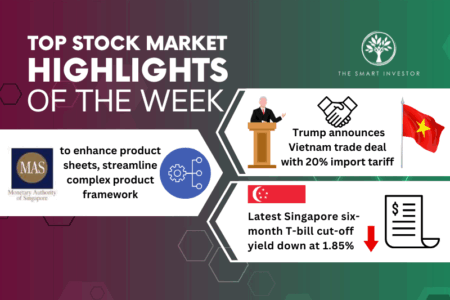Recall that Singtel announced its strategic reset during fiscal 2022 (FY2022) and for that year, its total dividend of S$0.093 was 24% higher than the S$0.075 paid in FY2021.
The telco’s recent FY2023 results were also encouraging as it paid out a higher core dividend of S$0.099 and declared a special dividend of S$0.05.
Times flies, and it has been nearly a year since Singtel (SGX: Z74) held its 2022 Investor Day.
Back then, the telco released details of its long-term strategy and plans as it mobilised its divisions to drive growth.
Last week, the blue-chip group released the slides for its latest Investor Day 2023 where it laid the foundation for further growth.
We now feature five highlights from Singtel’s latest Investor Day to determine if the group can continue growing.
1. Riding on tailwinds to grow
To kick us off, Singtel’s CEO Yuen Kuan Moon identified several tailwinds that he believes Singtel can ride on for further growth.
Market consolidation of telcos has occurred in four out of the six markets that Singtel operates in, allowing prices to gradually head higher.
He also sees positive industry trends such as the accelerating pace of enterprise digitalisation and higher roaming revenues.
Already, roaming revenues are up 33% in Singapore and have recovered to 65% of pre-COVID levels with more to come.
Meanwhile, Singtel will also leverage 5G by commercialising 5G services across industries such as manufacturing, security, healthcare, and transportation.
Elsewhere, the group also identified sizable untapped opportunities in regional associates’ markets for broadband penetration.
In India and Indonesia, the penetration rate stood at just 10% and 17%, respectively with the broadband industry growing at a compound annual growth rate (CAGR) of 15% for India and 8% for Indonesia.
Let’s not forget that the Singtel-Grab (NASDAQ: GRAB) digital bank, GXS Bank, also went live in August last year and has offered a savings account and loan product.
This bank is slated to launch in Malaysia and Indonesia by the end of this year and targets to break even on an EBITDA (earnings before interest, taxes, depreciation and amortisation) basis by FY2026.
2. Targeting double-digit ROIC
Singtel is targeting to increase its return on invested capital (ROIC) over time.
For context, its FY2023 ROIC stood at 8%, and management intends to increase this to a low double-digit figure by FY2026.
To do so, the group intends to increase efficiencies for both Optus and Singtel Singapore divisions and sell off or close loss-making businesses.
At the same time, the telco will reduce its capital intensity by spending less.
Singtel is also targeting to receive more than 20% of its EBITDA from growth engines such as acquisitions, asset recycling and third-party capital by FY2028.
The current proportion stands at 12% and is made up of regional data centres and NCS.
3. Rejuvenate its core consumer business
Over at its Singtel Singapore division, there are plans to rejuvenate the group’s core offerings.
One initiative is to drive the adoption of 5G for various events such as the National Day Parade and the upcoming Formula 1 Race.
There are plans to maximise roaming recovery and continuously upgrade its broadband services while being an all-in-one entertainment provider.
These are lofty goals that will need time, significant effort and resources to realise.
4. Providing a “One Optus” experience
Moving on to Singtel’s Optus division, plans are in place to integrate the consumer and enterprise divisions to provide a “One Optus” experience.
This initiative will target small and mid-market businesses along with larger enterprises and government bodies.
Optus has collaborated with SpaceX, a spacecraft manufacturer founded by Tesla’s (NASDAQ: TSLA) CEO Elon Musk, to bring direct-to-mobile LEO (low earth orbit) connectivity to Australia.
If successful, this partnership will bring nearly 100% internet coverage across the country, beginning with SMSes in late 2024 and voice and data from late 2025.
This initiative also complements Optus’ 5G network well and the division is progressing well on other LEO partnerships to grow this segment further.
5. Building a regional green data centre platform
Singtel possesses an extensive portfolio of digital infrastructure assets across Asia.
These comprise data centres, satellites, connectivity cables, and an enterprise platform.
In particular, data centres in Southeast Asia are expected to grow by more than 20% CAGR, backed by rapid digitalisation, growth in cloud services, and increasing adoption of artificial intelligence.
The data centre supply in this region is projected to grow at a CAGR of 19% till 2026.
To this end, Singtel is gearing up to build a regional green data centre platform.
With its current portfolio and a pipeline of data centre assets, the telco’s combined data centre capacity is slated to be more than 200 MW.
Growth can be achieved through organic growth in new markets such as Malaysia and Vietnam along with selective acquisitions.
Want to pave your child’s road to being a millionaire? Start today so they shield their money from pricey hawker meals and sky-high HDB costs. The first step is to set aside money to invest in dividend stocks. The second step is to grab a copy of our latest FREE report. Inside, we show you the secrets to investing for your children, including 3 SGX stocks to consider today for a wealthier future. Click HERE to download a copy now.
Disclosure: Royston Yang does not own shares in any of the companies mentioned.





